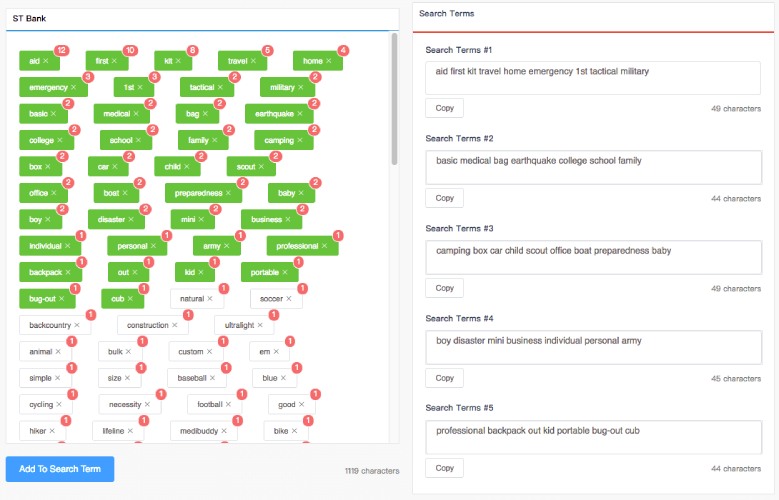Discover the working mechanism of Amazon backend keywords and understand how these simple terms can do wonders for your sales. Keep reading for more!
When it comes to Amazon SEO for better visibility of the product listing, most Amazon retailers would agree that keywords lay the foundation. Without the use of high-volume, relatable phrases, your landing page stands a slight chance of reaching out to potential customers and earning profit.
However, there are many branches within keyword optimization that sellers tend to overlook. Among these, Amazon backend keywords are a prime example. If you have yet to know about this particular term, why it is vital for the business, and how to use it correctly, let’s have a look at the article below!
What Are Amazon Backend Keywords?
As the name already indicates, Amazon backend keywords refer to phrases that are not placed at the front, visible to all shoppers. Instead, they belong backstage and are only viewable by Amazon’s algorithms.
Why Are Amazon Backend Keywords Important?
Despite the seemingly trivial position, backend keywords can reinforce the overall performance of an Amazon product listing. This is because they are still considered when the host engine scans through the entire catalog, looking for appropriate products.
To organize a ranking on the search result page every time a user looks for an item. If you manage to include enough phrases and terms that tie to what your store has to offer, then Amazon is more than willing to grant you a more favorable spot.
As a result, your products are exposed to a broader range of customers, essentially increasing the clickthrough and conversion rate.
At this point, you might wonder, “If backend keywords are that helpful for the business, then why not put all of them on the main page, where they can appeal directly to shoppers?”

Here is the thing. On the main landing page, Amazon store owners have to ensure the top-notch quality of the ad copy. Each line of content must be carefully written to reflect the unique selling points of the available item.
This is not the case with backend keywords. Businessmen are allowed to be creative around here. Feel free to put in common misspellings and variations that customers usually make about your products.
Or you can insert more detailed specifications of your products that you did not have enough space to put in the title. For example, brand names, model versions, slang usually used to describe the products, etc., can fit in nicely at the back and still do their job perfectly.
How To Find Suitable Backend Keywords
1. Utilize keyword research tools
While backend keywords might not be as pivotal to your landing page’s visibility as the main keywords, you still have to be selective. Do not randomly throw in phrases you assume customers might relate to and expect an excellent outcome. If you want to reap sizable conversions, use data-backed keywords.
There are multiple third-party websites allowing you to access its database, including records of past Amazon searches. Some even provide live searches so you can easily keep track of what customers need.
Even better, most of these platforms can estimate the search volume, monthly orders of a particular product, as well as the charged fee for PPC ad campaigns.
With such valuable insights, it will be much easier for you to pick out the most suitable keywords that deserve a place in the backend.
2. Take advantage of Amazon’s features
This procedure is more time-consuming, but it costs you nothing and directly reflects the trends of the website, so it is worth a try. All you have to do is open the Amazon marketplace and type in the first few letters of the keywords you have in mind.
They can either be the name of the product, the brand, or any other generic word. The built-in auto-complete will suggest the most common keywords that include everything you just typed in, so remember to note down all the phrases for later use.
Another place to look for the best Amazon backend keywords is customer reviews. Quickly scan through the testimonials of past shoppers and underline the way they refer to a particular product. This way, you can quickly put yourself into the shoes of the customers and understand their mindset.
How To Optimize Backend Keywords
1. No punctuation needed
Amazon does not require punctuation of any kind when it comes to keyword listing. Therefore, save yourself from using commas, question marks, exclamation points, etc. What is needed between two keywords is a simple space, and you are ready to go!
2. Stick to the character limit
The backend keywords only have enough space for no more than 250 characters. Stuffing as many terms inside as possible will not suffice. You have to look through all the possible phrases and narrow them down to the most promising keywords.
Start by excluding words that already appear repeatedly in the main ad copy. You should focus your resources on keywords that have yet to be used.
3. Monitor the performance
Once you have decided on which backend keywords to use, start putting them in and wait for a few days, then measure the outcomes. Check out the most important metrics to see if there has been any significant increase in terms of traffic or conversions. It is advisable for you to closely keep track of how backend keywords are doing and act accordingly.

4. Rotate the keywords
There is no need to use one set of backend keywords all over again, as it prevents you from exploring other alternatives and maximizing the benefits. Instead, switch things up regularly and experiment with different phrases and terms.
Conclusion
Despite looking relatively unimportant, the backend keywords on Amazon can deliver astonishing results that lead to even more organic sales and conversions for your store. For better execution of this particular feature, visit olifantdigital.com to get more tailored advice for your listing optimization!